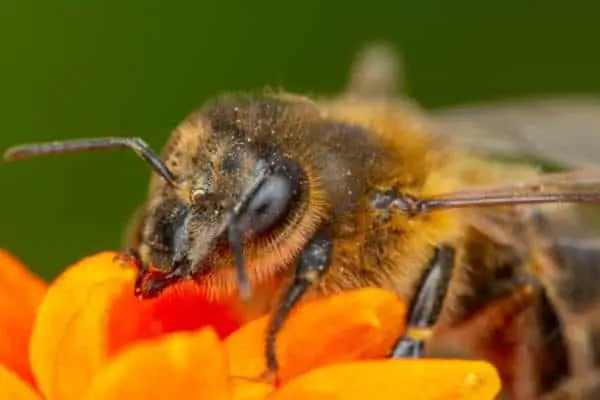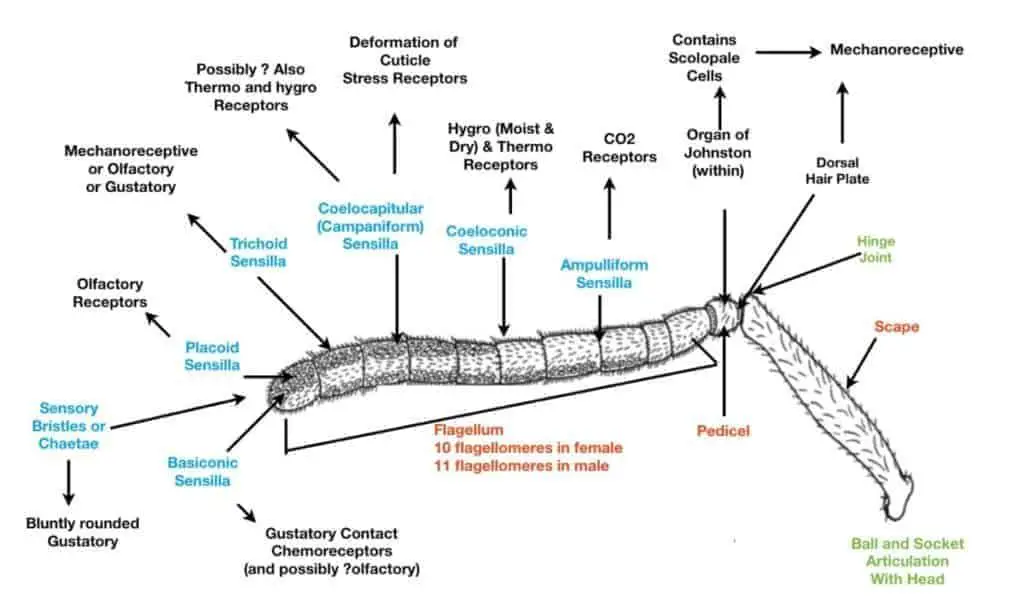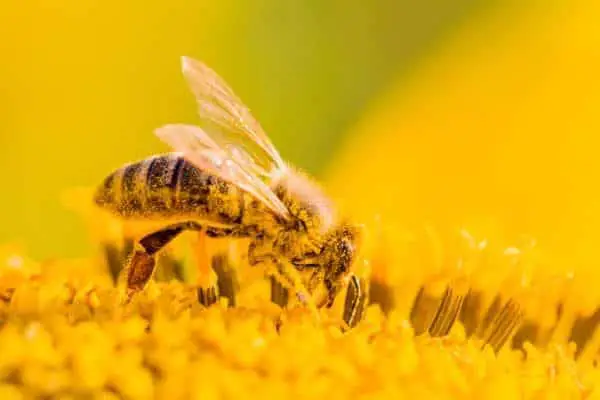Have you ever wondered if you are looking at a bee or a different flying insect? The antennae will give them away. Bees have long moveable antennae that provide them with an overload of information. Similar to the way the human brain is filled with neurons firing away, the antennae of a bee act as its own amazing sensory superhighway of information.

Bees gather the majority of their information from their antennae. With sensitive receptors for touch, taste, and smell, a bees antenna can sense temperature, humidity, carbon dioxide, and even gravity and wind speed. These “data powerhouses” are a bees primary investigation and knowledge-building tool.
We all love bees and know they are special. But what makes their antennae so unique? Continue reading to fully understand these amazing, “know all” appendages that keep our furry flying friends so informed.
Bee Antennae Structure
A bees antennae are made up of three main segments, and one connecting point:
– The Antennal Socket (Connects the antennae to the head).
– The Scape (located in the lower portion of the antenna).
– The Pedicel (located in the middle area of the antenna).
– The Flagellum ( located at the top end of the antenna).
The Antennal Socket
Although not officially part of the antenna, the antennal socket connects the antennae to the bees head. These bowel-like sockets allow each antenna to move independently (almost like a shoulder and socket).
From this socket, four muscles are used to connect the head of the bee to the scape.
These muscles are what allows the bee to have total control of the entire antenna.
The antennae are connected to the brain of the bee (via the scape) by a large double nerve.
This nerve plays an important role in the extraordinary sensory input from the antenna as it allows information to travel from the tip of the flagellum and into the brain.
The Scape
Forming the longest singular segment and connected to the antennal socket, the scape (basal segment) is responsible for allowing the movement of the antennae.
The scape, as mentioned above, is connected to the head via the antennal socket by four muscles.
The scape is connected by another pair of muscles to the flagellum which allows for movement in this distal segment of the antenna (think about the way a human arm or leg functions).
In addition to movement control, the scape provides a channel for nerves to run between opposing ends of each antenna.
The Pedicel
Similar to human elbows, the pedicel connects to the end of the scape by a hinge-like joint. This joint allows for more dynamic rotation of the flagellum.
In addition to movement, the pedicel contains the Johnston’s organ. This organ is located within the pedicel and at the base of the flagellum.
The Johnston’s organ is a finely adapted receptor that can detect very slight vibrations caused by movement in the antenna, and thus create effective communication between the brain and the flagellum. Read more about this receptor below.
The Flagellum
The uppermost segment of a honey bees antenna is called the flagellum.
Consisting of multiple smaller segments called flagomeres the flagellum is often used to indicate the gender of a bee.
In most species, a female bee has 10 flagomeres, while a male will have 11 sub-segments.
In other bee species such as the long-horned bee, the segments of a males flagellum are much longer than that of a female’s. Thus an easy way to distinguish between the two genders.
It is at these flagella where the magic of a bee’s sensory capabilities takes place.
Bee Antennae Sensory Receptors
On the outer layer of the flagellum, the antennae are covered with a blanket of different sensory receptors.
Each of these receptors is unique, both in shape and in function.
According to the International Journal of Insect Morphology and Embryology, antennal sensilla comprises of six variations: s. ampullacea, s. basiconica, s. campaniformia, s. coeloconica, s. placodea, s. trichodea A, B, C, and D, as well as several forms of setae.
Although there are multiple variations of receptors on the flagellum, the type of receptor (chemo, photo, mechanical) can usually be determined by their shape.
The shapes of receptors are often described as plates, hairs, pegs, and pits.
Plate organs
Plate organs are both chemoreceptors and photoreceptors. These sensilla are responsible for light and chemical reception.
It is believed that the large number of chemoreceptors on flying insects such as bees allows them to detect odors and orientate themselves towards the source. Hence a bees capability to find nectar.
It is common within honey bee colonies to find worker bees with more of these receptors than the drone bees.
Sensory Hairs
Hair receptors are mechanoreceptors and are responsible for touch. These hairs are so sensitive that in some bees, such as bumblebees, the electromagnetic field of a flower is able to stimulate them.
According to the Proceedings of the National Academy of Sciences of the United States of America (PNAS), while flying, bees accumulate a positive charge on their bodies.
Flowers have a negative electromagnetic charge. It is with this charge that the stimulation of sensory hairs moves the antenna.
When a bee lands on a flower, the opposite charges of each cancel out. This transfer leaves the flower with less of a negative charge.
The scientists from this study hypothesized that bees may use the charge of a flower in order to understand how recently the flower was visited by other bees.
Peg and Pit receptors
Just like plate receptors, pegs and pits are chemoreceptors. These sensors’ primary function is to identify and understand different smells.
Honey bees have more than double the odorant receptors when compared to fruit flies. This explains their extraordinarily olfactory abilities that include perception of pheromones, recognition of kin signals, and social communication.

The distribution of sensilla on a bee’s antennae is specific to its species and type.
For example, when looking at honey and bumblebees, worker bees have more chemoreceptors than the drones. This is because of their greater need to understand the texture of flowers, navigate in winds, and communicate with surrounding bees.
To further understand the distribution of these sensors, the picture of a honey bee antenna from scientificbeekeeping.co.uk above shows how olfactory receptors and tactile receptors are found at the tip of the antennae while thermo and CO2 receptors are located more towards the center.
The Johnson’s Organ
Although mentioned above, the Johnson’s organ should be taken particular notice of, as it plays a major role in a honey bee’s spectacular sensory array and allows it to “hear”.
Also known as the “bees ear” this receptor is able to pick up tiny vibrations in the air. A bee uses this membrane in a similar way that we use our eardrum.
When a vibration is detected by the sensilla on the flagellum, it travels down the pedicel, stimulates the Johnson receptor, and is then transferred by nerves, through the scape, and into the brain.
This function of “hearing” allows bees to understand each other in the dark by the sound of their wings.
In addition to allowing the bee to hear, the Johnson’s receptor is capable of perceiving very slight changes in the antennae’s position. This allows the bee to determine her flight speed and airflow.
We have a whole article dedicated to how bees hear. It is actually fascinating if you are interested. The article is called, Do Bees Have Ears?
How Does A Bee Use Its Antennae?
With a basic understanding of a bees antenna structure, the question of how exactly a bee uses its antenna may arise.
When watching a bee, it is easy to see how their antennae are constantly on the move.
Feeling, seeing, hearing, smelling, and tasting, a bees antenna takes in all the sensations that a human’s five sensors do.
But for what does a bee need all this information?
Finding Food
The ability for a bee to see and feel surface texture allows a forager to find her way by navigating the intricate petal patterns known as nectar guides.

This is why, as mentioned before, forager bees have more chemo- and tactile receptors than males do.
Beyond their ability to see the nectar guides, the sensors at the tip of the antenna can feel the variations of texture on each flower.
This helps the bee determine the type of flower as well as the direction of the food.
With their unique sense of “smell”, bees can navigate themselves towards food sources and away from neighboring hives.
A bees antennae are their personal GPS system. Using each antenna individually the bee can navigate towards its chosen destination. By following the antenna with the strongest signal and constantly adjusting its flight path, a honey bee can zone into an exact location.
Furthermore, being so sensitive to sweetness, bees are able to decide if the nectar of a flower is worth harvesting or if she should continue to another. This sweetness detection is an amazing asset to the colony as a whole, as it massively increases its productivity levels.
Dancing In The Dark
The antennae allow bees to “see” each other in the dark and read their positioning. Using the Johnson’s organ, bees can sense the “dancing” vibrations of other bees.
Furthermore, antennae play a role in the transfer of food from bee to bee (trophallaxis). Bees signal that they are ready by using their antennae and use them to aline correctly.
Because these sensors can detect changes in carbon dioxide, bees in the hive can “sense” when a potential predator is near. Sensing increased CO2 levels within the hive, due to the exhalation of a threatening creature, the colony knows to be on its guard.
Regulating The Hive
Antennae are used to monitor movement and development within the hive. By tracking the Queen’s pheromones, worker bees are able to monitor her behavior as well as sense danger (as mentioned above).
Through various pheromones in the hive, workers are able to track the numbers of foragers. When the workforce is large enough, the transition from nurse bees into foragers can be slowed.
The Wrap Up
Containing an abundance of sensory receptors, including; taste, smell, sound, touch, sight, speed, temperature, and vibration, the antennae of a bee are an essential part of their functionality and survival.
A bees antennae provide them with food, communication, safety, and an amazing ability to cooperate with each other.
With their unique ability to freely move, and finely tuned reception, a bee’s antennae truly are a magnificent sensory structure that nature should be proud of.
